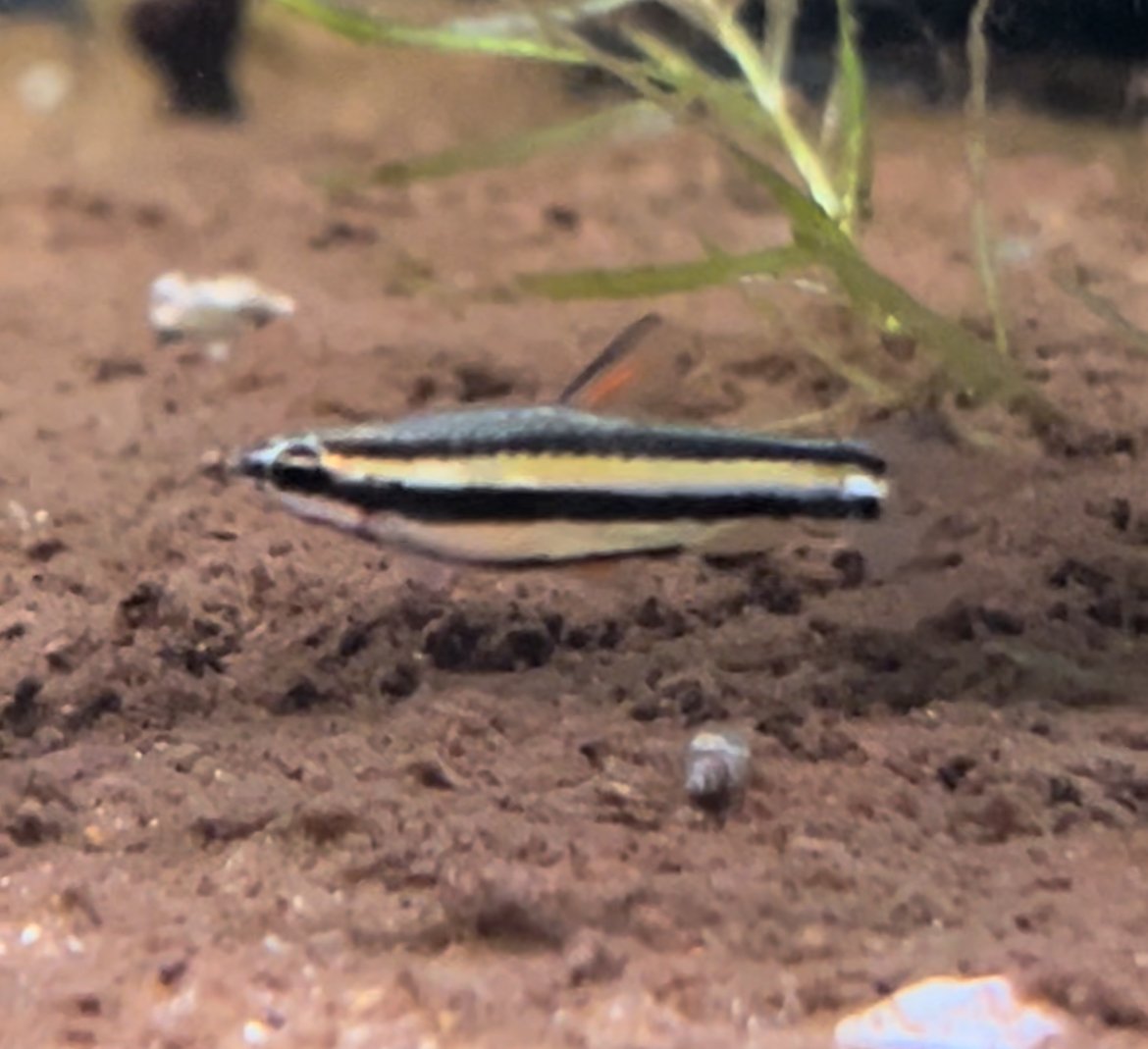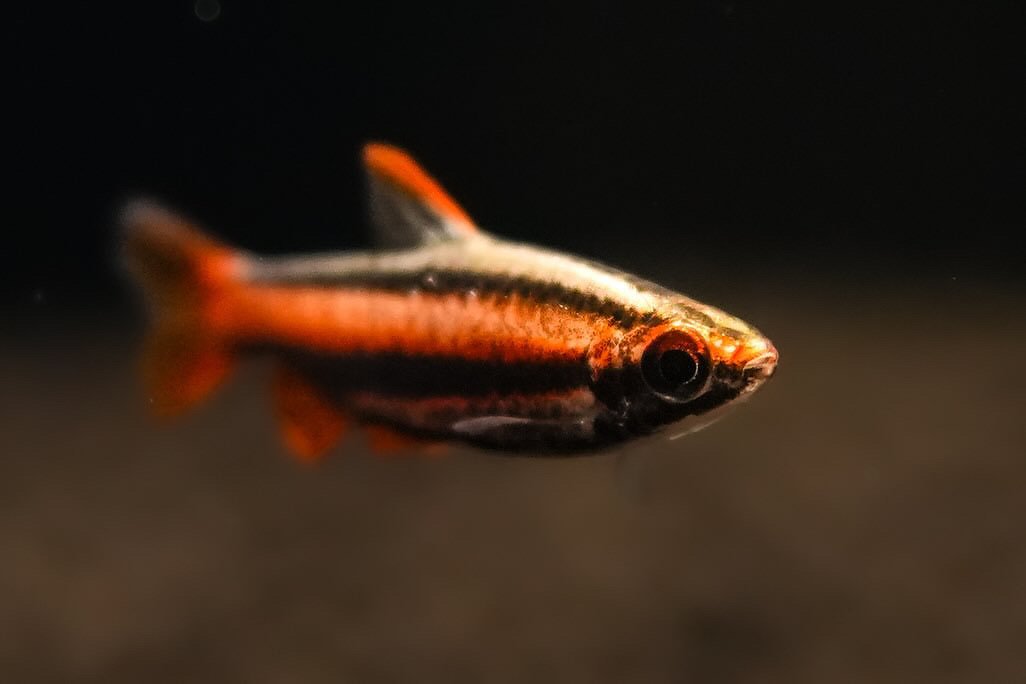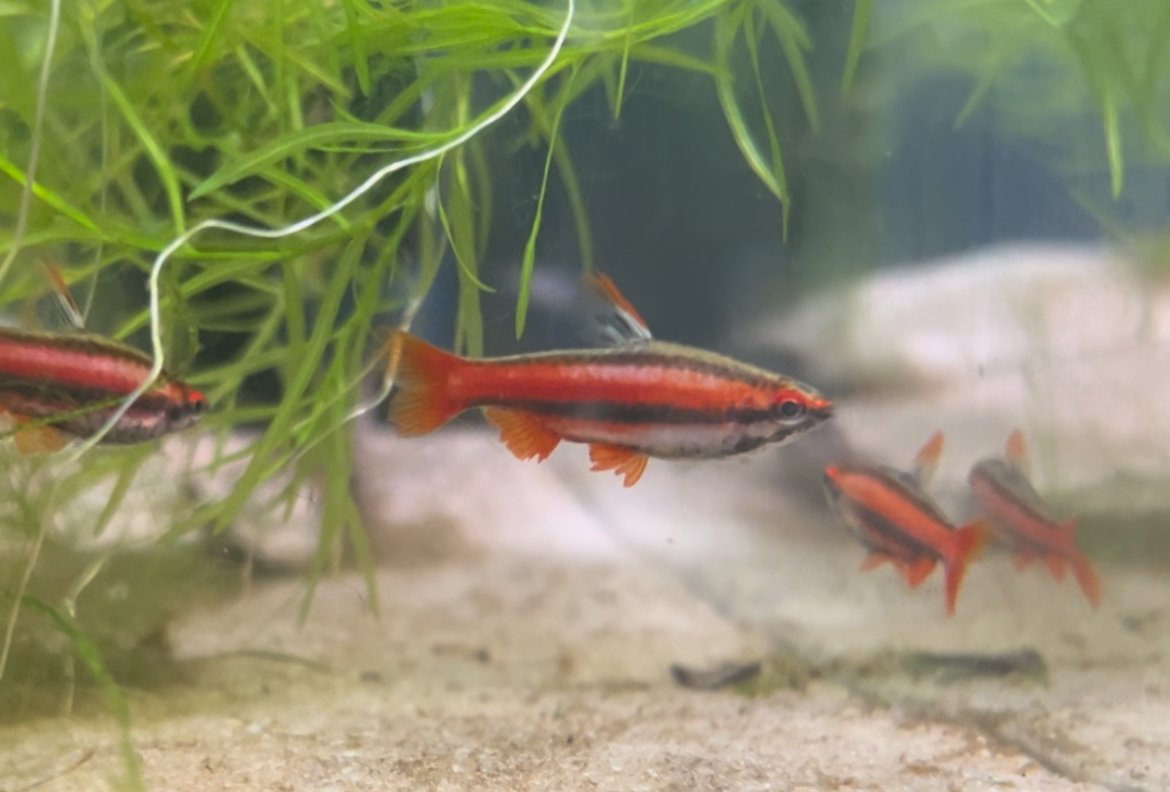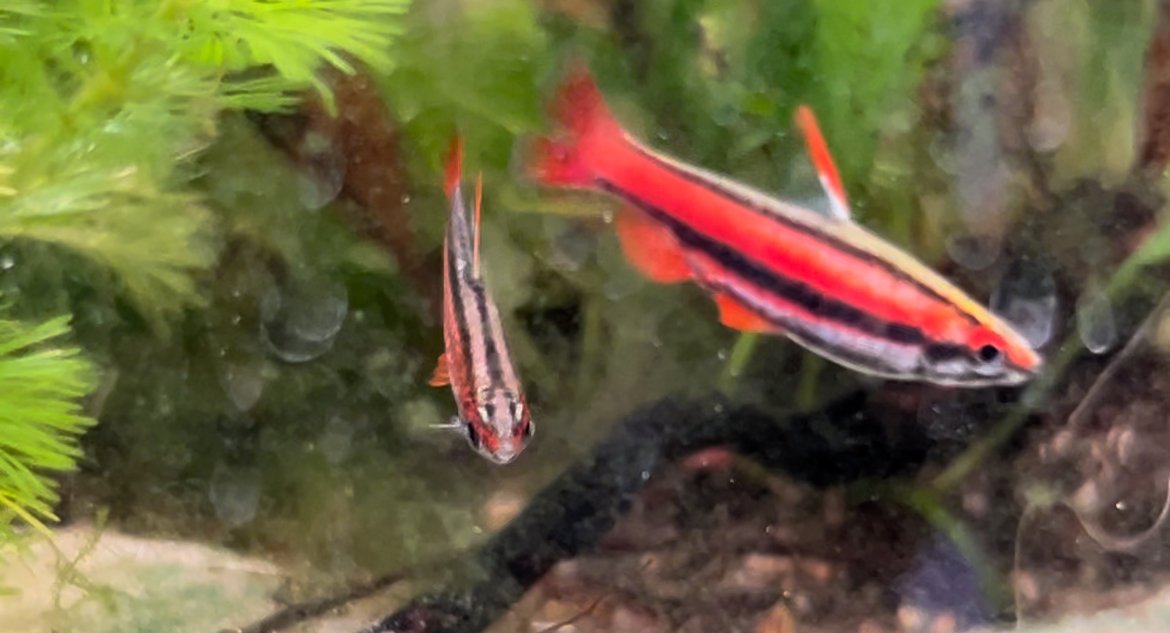 Image 1 of 2
Image 1 of 2

 Image 2 of 2
Image 2 of 2



Cenepa Red Pencilfish- WILD
The Cenepa Red Pencilfish (Nannostomus sp.), also known as the Super Red Cenepa Pencilfish, is a recently discovered freshwater species native to the Rio Cenepa, a tributary of the Amazon River Basin in Peru. This diminutive fish, reaching up to 1.5 inches (3.5 centimeters) in length, is celebrated for its vibrant scarlet coloration, especially prominent in males, making it a striking addition to well-maintained aquariums.
In their natural habitat, these fish inhabit tannin-stained blackwater environments characterized by low mineral content. To replicate such conditions in captivity, it’s advisable to maintain soft, acidic water with a pH between 4.0 and 7.0 and temperatures ranging from 75°F to 82°F (23°C to 27°C). A heavily planted aquarium with a dark substrate, complemented by floating plants and driftwood, can help mimic their native surroundings and reduce skittishness. Gentle filtration, such as an air-powered sponge filter, is recommended to maintain water quality without creating strong currents.
Cenepa Red Pencilfish are peaceful and exhibit shoaling behavior; thus, keeping them in groups of at least ten individuals is beneficial. This not only encourages natural behavior but also minimizes aggression among males. They coexist well with other small, non-aggressive species like smaller tetras, micro rasboras, dwarf barbs, and compatible Corydoras catfish. Due to their small size and somewhat timid nature, they may not thrive in typical community aquariums with larger or more boisterous species.
Feeding these omnivorous fish is straightforward, as they readily accept high-quality dried foods such as granules, flakes, and sinking pellets. Supplementing their diet with live or frozen foods like bloodworms, daphnia, and tubifex once or twice a week can enhance their health and coloration. While not mandatory, occasional offerings of blanched vegetables like spinach, broccoli, and zucchini can provide additional nutrients.
Breeding the Cenepa Red Pencilfish can be rewarding yet challenging. Setting up a separate breeding tank with mature, soft, and slightly acidic water is essential. Providing fine-leaved plants or spawning mops offers suitable sites for egg deposition. After spawning, it’s advisable to remove the parents to prevent egg predation. Eggs typically hatch within 36 to 72 hours, and the fry become free-swimming after 3 to 4 days, at which point they can be fed infusoria or powdered first foods, gradually transitioning to larger foods as they grow.
In summary, the Cenepa Red Pencilfish is a captivating species that brings vibrant color and dynamic behavior to aquariums. With proper care, suitable tank conditions, and appropriate tank mates, they can thrive and become a highlight in both nano and well-planted aquarium setups.
The Cenepa Red Pencilfish (Nannostomus sp.), also known as the Super Red Cenepa Pencilfish, is a recently discovered freshwater species native to the Rio Cenepa, a tributary of the Amazon River Basin in Peru. This diminutive fish, reaching up to 1.5 inches (3.5 centimeters) in length, is celebrated for its vibrant scarlet coloration, especially prominent in males, making it a striking addition to well-maintained aquariums.
In their natural habitat, these fish inhabit tannin-stained blackwater environments characterized by low mineral content. To replicate such conditions in captivity, it’s advisable to maintain soft, acidic water with a pH between 4.0 and 7.0 and temperatures ranging from 75°F to 82°F (23°C to 27°C). A heavily planted aquarium with a dark substrate, complemented by floating plants and driftwood, can help mimic their native surroundings and reduce skittishness. Gentle filtration, such as an air-powered sponge filter, is recommended to maintain water quality without creating strong currents.
Cenepa Red Pencilfish are peaceful and exhibit shoaling behavior; thus, keeping them in groups of at least ten individuals is beneficial. This not only encourages natural behavior but also minimizes aggression among males. They coexist well with other small, non-aggressive species like smaller tetras, micro rasboras, dwarf barbs, and compatible Corydoras catfish. Due to their small size and somewhat timid nature, they may not thrive in typical community aquariums with larger or more boisterous species.
Feeding these omnivorous fish is straightforward, as they readily accept high-quality dried foods such as granules, flakes, and sinking pellets. Supplementing their diet with live or frozen foods like bloodworms, daphnia, and tubifex once or twice a week can enhance their health and coloration. While not mandatory, occasional offerings of blanched vegetables like spinach, broccoli, and zucchini can provide additional nutrients.
Breeding the Cenepa Red Pencilfish can be rewarding yet challenging. Setting up a separate breeding tank with mature, soft, and slightly acidic water is essential. Providing fine-leaved plants or spawning mops offers suitable sites for egg deposition. After spawning, it’s advisable to remove the parents to prevent egg predation. Eggs typically hatch within 36 to 72 hours, and the fry become free-swimming after 3 to 4 days, at which point they can be fed infusoria or powdered first foods, gradually transitioning to larger foods as they grow.
In summary, the Cenepa Red Pencilfish is a captivating species that brings vibrant color and dynamic behavior to aquariums. With proper care, suitable tank conditions, and appropriate tank mates, they can thrive and become a highlight in both nano and well-planted aquarium setups.
The Cenepa Red Pencilfish (Nannostomus sp.), also known as the Super Red Cenepa Pencilfish, is a recently discovered freshwater species native to the Rio Cenepa, a tributary of the Amazon River Basin in Peru. This diminutive fish, reaching up to 1.5 inches (3.5 centimeters) in length, is celebrated for its vibrant scarlet coloration, especially prominent in males, making it a striking addition to well-maintained aquariums.
In their natural habitat, these fish inhabit tannin-stained blackwater environments characterized by low mineral content. To replicate such conditions in captivity, it’s advisable to maintain soft, acidic water with a pH between 4.0 and 7.0 and temperatures ranging from 75°F to 82°F (23°C to 27°C). A heavily planted aquarium with a dark substrate, complemented by floating plants and driftwood, can help mimic their native surroundings and reduce skittishness. Gentle filtration, such as an air-powered sponge filter, is recommended to maintain water quality without creating strong currents.
Cenepa Red Pencilfish are peaceful and exhibit shoaling behavior; thus, keeping them in groups of at least ten individuals is beneficial. This not only encourages natural behavior but also minimizes aggression among males. They coexist well with other small, non-aggressive species like smaller tetras, micro rasboras, dwarf barbs, and compatible Corydoras catfish. Due to their small size and somewhat timid nature, they may not thrive in typical community aquariums with larger or more boisterous species.
Feeding these omnivorous fish is straightforward, as they readily accept high-quality dried foods such as granules, flakes, and sinking pellets. Supplementing their diet with live or frozen foods like bloodworms, daphnia, and tubifex once or twice a week can enhance their health and coloration. While not mandatory, occasional offerings of blanched vegetables like spinach, broccoli, and zucchini can provide additional nutrients.
Breeding the Cenepa Red Pencilfish can be rewarding yet challenging. Setting up a separate breeding tank with mature, soft, and slightly acidic water is essential. Providing fine-leaved plants or spawning mops offers suitable sites for egg deposition. After spawning, it’s advisable to remove the parents to prevent egg predation. Eggs typically hatch within 36 to 72 hours, and the fry become free-swimming after 3 to 4 days, at which point they can be fed infusoria or powdered first foods, gradually transitioning to larger foods as they grow.
In summary, the Cenepa Red Pencilfish is a captivating species that brings vibrant color and dynamic behavior to aquariums. With proper care, suitable tank conditions, and appropriate tank mates, they can thrive and become a highlight in both nano and well-planted aquarium setups.







